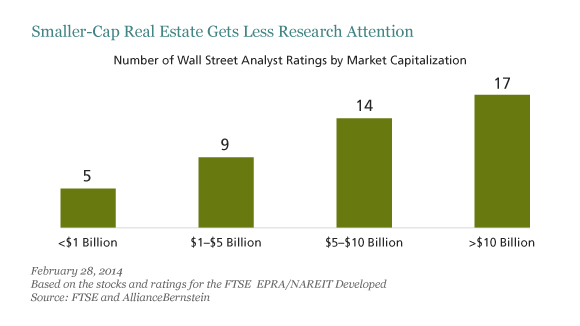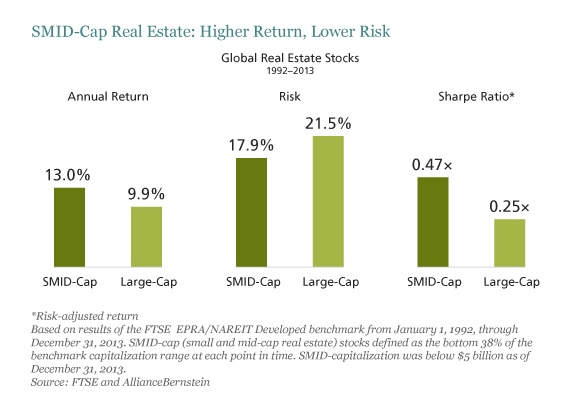After a spectacular five-year run, global real estate stocks look headed for a period of more normal returns. We think winning in this space will require a more discriminating eye—and venturing into the often neglected nooks and crannies of the smaller-cap real estate world.
Real estate stocks are a multifaceted bunch, spanning a variety of sub-industries, each with its own set of advantages and challenges. Yet the action in the space is dominated by a small band of very large stocks, which get a disproportionate share of Wall Street analyst coverage (Display 1) and are typically used as proxies for the entire asset class by investors seeking generous and stable yields, frequently via exchange-traded exchanges or other passive strategies.

This favoritism leaves a mass of small- and mid-cap (or SMID-cap) real estate stocks flying under the radar and trading at lower valuations than the big names, many times despite similar or better operational health and growth prospects. This is fertile hunting ground for nimble stock pickers who do their homework and are familiar with the neighborhood.
Indeed, since 1992, SMID-cap real estate stocks have collectively delivered higher returns than their large-cap peers, with less volatility, resulting in superior risk-adjusted returns, as measured by Sharpe ratios (Display 2). Unsurprisingly, much of this alpha potential stems from investors’ general indifference. Because SMID stocks are underfollowed and often misunderstood, they tend to get hit harder than their larger, more liquid counterparts when faced with near-term controversy, which often creates opportunity.
 Many active strategies use large, high-profile names to express their country or sector preferences, which can be significant performance drivers. Larger stocks have the liquidity needed to quickly increase or decrease portfolio exposures. But by limiting exposures to just the biggest names in the category, investors forgo the potentially bigger payoffs in many of the smaller real estate stocks, which tend to be influenced more by company-specific catalysts.
Many active strategies use large, high-profile names to express their country or sector preferences, which can be significant performance drivers. Larger stocks have the liquidity needed to quickly increase or decrease portfolio exposures. But by limiting exposures to just the biggest names in the category, investors forgo the potentially bigger payoffs in many of the smaller real estate stocks, which tend to be influenced more by company-specific catalysts.
US lodging stocks offer a prime example. A single company (Host Hotels & Resorts) accounted for roughly 40% of the US lodging market capitalization of $37.2 billion at year-end 2013. Of the remaining 11 US lodging stocks in the global benchmark, nine had a market cap of less than $3 billion, while two had market caps in the $3 billion to $4 billion range. Propelled by the US economic recovery, rising occupancy rates and limited room supply growth, US lodging stocks strongly outperformed both the US and global real estate indices.
Clearly, an overweight in Host Hotels alone would have been rewarding. But why miss out on even stronger returns enjoyed by smaller lodging players, many of which rose on both favorable industry trends and growing investor recognition of their individual competitive strengths? Take RLJ Lodging Trust, which entered 2013 trading at a significant discount to peers, as investors sought safer accommodations in rivals with premium properties in prime gateway cities such as New York and San Francisco. Though it lacked a presence in gateway cities, RLJ was also nearing the completion of renovations at many of its hotel properties, setting the stage for a dramatic surge in cash flows. As the company’s financial improvement became increasingly apparent, the stock soared, outperforming Host Hotels.
SMID caps also allow active managers to stay in the game and add value even when country or sector opportunities aren’t particularly provocative. So, when searching for alpha potential in real estate stocks, don’t forget to scour the smaller neighborhoods.
The views expressed herein do not constitute research, investment advice or trade recommendations and do not necessarily represent the views of all AllianceBernstein portfolio managers.